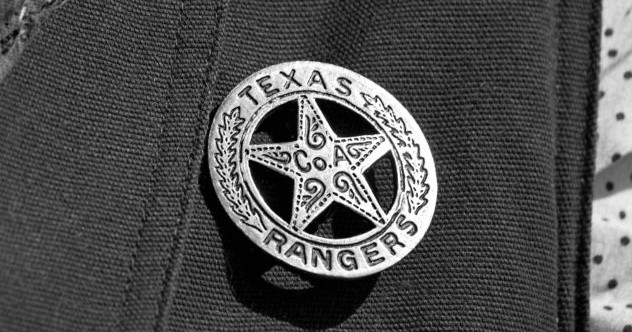Now Reading: 10 Surprising Stories About the Texas Rangers
-
01
10 Surprising Stories About the Texas Rangers
10 Surprising Stories About the Texas Rangers

The Texas Rangers aren’t just a baseball team. And they aren’t just a television show that focused on the not-so-real-life tales of Cordell Walker and his karate-kicking, bad-guy-beating ways. No, they were a real law enforcement organization—and still are! The baseball team and the television series were both named in their honor, of course. But the real Texas Rangers are way cooler than each of those (admittedly cool) things. The law enforcement arm holds significant power and influence in the Lone Star State. And that police body has quite the shocking, fascinating, and even intimidating history behind it.
In this list, we’ll dive deep into the real-life Texas Rangers. Their formation was both unique and controversial. Their rise to power and influence over Texas was both violent and hard-fought. And the legacy they leave goes far beyond Chuck Norris’ television turn. This is how Texas was fought for and won by one of the most powerful—and, at times, brutally abusive—law enforcement organizations to ever appear in America.
Related: Top 10 Grisly Tales From The American Frontier
10 It All Began 200 Years Ago
Texas Rangers: For More Than 200 Years
The Texas Rangers were first formed long before Texas joined the Union, and even before it became its own Republic. In 1821, Mexico was attempting to gain its independence from Spain. At the time, it owned Texas. But simultaneously, American settlers were pushing deep into the region. Among those was a man named Stephen F. Austin. He managed to obtain what was known as an “empresario contract” for himself that year from Mexico, and with it, he claimed for himself and his (white American) compatriots all the land north of Corpus Christi.
Newcomers flooded in from other parts of America and tried to settle the place. But life was very hard for many reasons, chief among them the fact that local indigenous populations and long-ago settled Mexicans alike hated the intrusion. As violence inevitably ramped up, Austin lobbied Texas’s nascent American leadership for assistance. They sent out a pretty wimpy militia to save Austin’s settlements. He (rightly) didn’t think it was enough to do the job, though. And so, over the next couple of years, the settler decided he’d have better luck if he just did the whole thing himself.[1]
9 The First On-Duty Death of a Ranger
Who Were The Texas Rangers and Why Are They Famous?
One of the first men to settle in Stephen F. Austin’s contested Texas colony was a North Carolina native named John Jackson Tumlinson. John built a homestead right along the Colorado River near the present-day city of Columbus. There, in 1821, he was elected to become the local area’s magistrate. From the very start, bandits were at the forefront of his mind for him and the other residents. John’s one big goal was to protect the settlers around him from the violent and deadly risks of the frontier. So, when Austin’s opportunity to start the militia that would become the Texas Rangers popped up, Tumlinson jumped at the chance.
Sadly, just after the Rangers were officially formed and Tumlinson had been deputized, tragedy struck for Tumlinson’s family and the men and women of Columbus. Late in 1823, John was traveling to San Antonio for a meeting to discuss security in the border region. Along the way, a group of warriors belonging to the local indigenous Waco tribe came upon him, ambushed him, and killed him. Even worse, his body was never recovered for a proper burial. The only reason we even know what happened now is because one member of John’s traveling party managed to escape and sound the alarm.
In the end, Tumlinson’s death did a considerable amount to push Austin to even more aggressively fill out the Rangers and get them working on behalf of the settlers. Austin was so moved by Tumlinson’s murder that he rushed ahead with even more grandiose private security plans than he’d otherwise intended. It also inspired Tumlinson’s own son. For the next four decades, Captain Peter F. Tumlinson served as a deputized member of the Texas Rangers. He was so crestfallen by his father’s death that it inspired him to live the rest of his life honoring him as one of the original Rangers who turned the department into what it would later become. Impressive![2]
8 A Crusade Against Mexico
Texas Rangers vs. Mexican Lancers : The Brutal Story Of The Battle Of Huamantla | FULL DOCUMENTARY
Because the original Texas Rangers’ purpose was to provide security for frontier Texans, they very often scuffled with Mexican nationals. And in turn, it wasn’t too long before the Rangers were fighting on the forefront of the Mexican-American War. From 1846 through 1848, the Rangers fought on America’s side in the short but bloody skirmish.
However, even though they supported the Americans, they didn’t really want to link up with the Americans. While the U.S. Army was battling in regiments of fully assimilated soldiers towing the company line, the Rangers kept their distance by retaining their own uniforms and avoiding anything issued by the Army. They carried out their own missions and acted like their own militia. So, while they were pro-America, they very much did their own thing—like true mercenaries.
Major military generals, including Winfield Scott and future President Zachary Taylor, admired the ferocity of the Texas Rangers in battle. They acted with such violence toward Mexican forces that the military men to the south took to calling them “Los Diablos Tejanos.”
Unfortunately for Mexico and its people, that name wasn’t just a fun phrase to identify the Rangers; it was all too real. In one especially terrible moment during the Mexican-American War, the Rangers went down to Monterrey, Mexico, and killed more than 100 civilians in what is still regarded as one of the worst massacres of the conflict. It solidified the Rangers’ reputation for brutal violence. And with no real American oversight, they had nobody to answer to after the deed was done.[3]
7 World-Class Indian Fighters
Texas Rangers vs. Comanche Raiders : The Battle of Antelope Hills
It wasn’t just the Mexican military that drew the Rangers’ ire. For several decades before the Mexican-American War, the Texas Rangers spent much of their time fighting against various Native American tribes, too. In fact, one of the reasons Austin first founded the Rangers was to ward off native incursion into the new American settler colony (that was on, uh, native land…).
In 1838, by the time Texas was its own nation, the short-lived country was setting its own precedent on that. That year, with President Mirabeau B. Lamar presiding over the nation of Texas, he petitioned the Legislature for a full column of frontier guards. Within days, the nation’s Secretary of War, Thomas J. Rusk, sent up several companies of Rangers.
Lamar immediately funded and outfitted the regiment, and the next thing the men knew, they were out on the frontier. With that, the Texas Rangers had now become a true military outfit worthy of protecting an entire nation. For the next several decades, the Rangers engaged in various skirmishes with Indian tribes up and down Texas’s border regions.
Most famously, in 1858, Ranger John Salmon “Rip” Ford led a regiment on a brutal six-month pursuit of a vaunted group of Comanche warriors. More than 80 Comanches wound up dead during that half-year battle, compared to just one single Texas Ranger. In time, lopsided victories like that quickly catapulted the crew into Texas lore.[4]
6 Support for Secession
LEGENDS OF THE OLD WEST | Texas Rangers Ep1 – “Civil War”
As soon as the Civil War erupted, Texas joined the South. The Rangers were quick to join, too. But not at first, you see. Just as the Civil War began to erupt in 1861, and Texas became the seventh state to officially secede, the Texas Rangers were explicitly asked not to fight for the Confederacy. Instead, they were ordered to remain on the Mexican border and continue protecting settlements. But just a few months into the Civil War, in 1861, Texas’s Confederate regiments needed help. Badly. So, a thousand-man-strong “Frontier Regiment of Rangers” was called on to fight against the Union—and fight they did.
Not even a full year later, in the middle of 1862, Rangers were already fighting Union soldiers far more than they’d been fighting native groups before that. They began to play such critical roles in battles all over Texas—and win so many of those battles decisively—that Confederate commanders Robert E. Lee and Albert Sidney Johnston started to closely study their tactics.
By late 1863, the Rangers’ success proved to be too much to ignore, and they were officially absorbed into the Confederate Army. Among the bands newly created with that move came the Eighth Texas Cavalry—which was then (and still is today) more commonly known as Terry’s Texas Rangers. Led by frontiersman Benjamin Franklin Terry, the group was valiant in skirmishes against the North in the Civil War. Even after the Confederacy weakened, the Rangers stayed strong. And when the Civil War officially ended, they went right back home to protect frontier settlers just as before.[5]
5 Catching Outlaws
Sam Bass: The Manhunt, The Crime, and The Tragic End of a Wild West Bandit and Texas Folk Hero.
Sam Bass was one of the most notorious outlaws of the 1870s. He regularly robbed trains and banks across the Great Plains and down into Texas. In 1877, for example, Bass held up a train outside the city of Big Springs, Nebraska. Bass and his gang walked away with more than $60,000—an insane sum of money at that time—and hightailed it down to Texas. There, they intended to lie low for a while until the heat was turned off.
That’s not what happened, though. When Bass got down to the Lone Star State, he immediately started robbing banks and other businesses. Texas Rangers gave pursuit, and by early 1878, they had caught up with him. Finally, on July 21, 1878, things came to a head at Round Rock. There, Bass tried to rob a store. Rangers showed up and engaged him in a gunfight in the town square. As luck would have it, the first Ranger on the scene was a man who just so happened to be getting his haircut in a barbershop down the block. He hopped out of the barber’s chair, rushed over to where Bass was robbing the store, and pulled out his pistol.
What happened next seemed to defy the odds even further. The Texas Ranger with the half-cut hair got a few good shots off and struck Bass directly with one of them. But it wasn’t enough to kill the notorious outlaw. Instead, while bleeding profusely the entire time, Bass vanished from sight. The Rangers had a trick up their sleeve, though: they would use the (literal) trail Bass left behind him to capture the outlaw. Of course, that trail was being dripped out step by step in spurts of dark red blood. Creepy! Several hours and more than six miles later, Rangers caught up to the dying Sam Bass, and that was that.[6]
4 The Tragedy at Porvenir
La Matanza: The Darkest Hour of the Texas Rangers
Undoubtedly, the most shameful moment in the history of the Texas Rangers occurred in 1918. In January of that year, Captain J.M. Fox led a group of Rangers to a riverfront settlement in south Texas called Porvenir. There, local Mexicans were supposedly working as spies against the Rangers. And other local Mexicans were rumored to have been part of a deadly raid against another white American settlement a few months earlier. So, Fox’s men entered Porvenir under the cover of darkness to root out these supposed spies and raiders. But what happened next was both confusing—and terrible.
According to Fox and his men, they entered Porvenir at night and began searching the village. Suddenly, they came under fire from behind. Shocked and in danger for their lives, the Rangers opened fire and killed 15 bandits. Dozens of others supposedly fled into the hills, never to be seen again. Sounds heroic, right? Well, maybe. Except that’s not actually what happened.
As it came to light much later, Fox and his men hadn’t actually gotten in a fight with a bunch of bandits. Instead, the Mexicans involved in the massacre were local farmers who had absolutely nothing to do with any heists or battles. Even worse, their deaths were horribly cruel. Rather than some supposed chaotic firefight, Texas officials later determined that Fox’s men took the Mexicans’ weapons from them before they were killed. So, they weren’t bandits or enemy combatants at all—they were helpless people who’d been taken prisoner and then slaughtered.
Even after the jig was up, Fox tried to claim that the men killed had been “thieves, informers, spies, and murderers,” but thankfully, Ranger leaders didn’t buy it. They disbanded Fox’s company, straight-up fired five of the Rangers involved, and accepted the resignations of another three of them. Captain Fox was also forced to resign from his job in the aftermath of the massacre. And to this day, it remains one of the darkest moments in Texas Rangers history.[7]
3 Politicians Take Oversight
A year after the terror at Porvenir, Texas state representative Jose Canales took action. At the time, Canales was the only Mexican-American serving in Texas’s state government. Using his powerful position, and concerned about the innocent Mexicans killed at Porvenir, he filed misconduct charges against 19 Rangers. He also filed a bill that would have cut funding for the Texas Rangers and slashed their force—which proved very unpopular in Texas. Ultimately, the bill was never passed. But some Texans welcomed Canales’ ensuing investigation into the Rangers. And what he found was downright shocking.
Most notably, Canales’s investigation disbanded a special (and controversial) group of the Texas Rangers known as the Loyalty Rangers. It also quashed several other companies of Rangers, too. And most impressively, it kicked off a much higher standard for the remaining Rangers. That came about because Canales’s look into the group’s activities found that between 1914 and 1919, Texas Rangers had killed nearly 5,000 Hispanic citizens of both the United States and Mexico. Texas politicians were shocked at the amount of killing taking place under the auspices of law enforcement, and Ranger reform was soon to follow.[8]
2 Fighting Against Integration
Ask History: Who are the Texas Rangers? | History
For the next decades, the Rangers settled into their new role with more oversight. But they would have darker days, too. One period came in 1956. Two years before, the Supreme Court struck down racial segregation in American public schools via Brown v. Board of Education. Immediately, Texas business leaders and politicians were outraged at the decision. And in 1956, tensions bubbled over. That August, in the city of Mansfield, a mob formed. More than 400 white men rushed Mansfield High School. They vowed to fight against desegregation. They even assaulted a district attorney who had come to the scene. For hours, the men rode roughshod in the streets of Mansfield as they reacted to the Supreme Court’s ruling.
Texas Governor Allan Shivers knew he had to take action. But what he did was shocking—and sad. He ordered the Texas Rangers to descend upon Mansfield. It wasn’t to protect local Black citizens, though. Instead, Shivers called the local chapter of the NAACP “agitators” and blamed them for counter-protests. Shivers also ordered Rangers to “arrest anyone, white or colored, whose actions… represent a threat to the peace at Mansfield.” That order meant the Rangers could arrest Black students simply trying to register for school, since their presence incited the white mob.
As a result, not a single Black student attended Mansfield High School in 1956. The Rangers also focused attention upon the NAACP and local Black protesters. They arrested people spreading pro-desegregation pamphlets, which agents called “inflammatory literature.” As one NAACP lawyer recalled, the Rangers were there to “protect the will of the mob.” You know, the white mob. Of course, history would prove that desegregation was critically important. But at the time, the Texas Rangers shamefully didn’t see things that way.[9]
1 Averting an Assassination
Porfirio Diaz: Mexico’s Gentleman Dictator
The Rangers had one incredible international achievement to their credit. In 1909, Mexican President Porfirio Diaz met with William Howard Taft in both El Paso, Texas, and its neighboring border community, Ciudad Juárez, Mexico. The cross-river meetings concerned economic security and border issues. It was a landmark gathering for both Mexico and the United States. Many at the border hoped the event could usher in a period of security for both countries.
As expected, a large security presence was on hand for the affair. More than 4,000 American and Mexican troops were in the area to guard against unrest, and both cities’ police departments worked overtime. FBI agents and U.S. Marshals descended to provide extra care. Plus, an entire company of Texas Rangers was in El Paso to oversee security. In fact, many of the Rangers served as sharpshooters to guard President Taft during a scheduled parade through the west Texas town. But without one Ranger’s observant actions and quick thinking, the meeting would have ended in tragedy.
Hours before the El Paso gathering, Ranger Private C.R. Moore stopped a would-be assassin. Moore was in the crowd at the time when he noticed a person with what looked like a pencil sticking out of his sleeve. Something didn’t sit right with Moore, and he looked closer. When he checked the man’s sleeve, the horror came to light: it wasn’t a pencil, but a handgun. The man, a Mexican, was there to assassinate President Diaz. Had Moore not caught him, there’s no telling what might have happened. Thankfully, Ranger Moore’s quick thinking averted what could have been an ugly international incident.[10]
fact checked by
Darci Heikkinen























